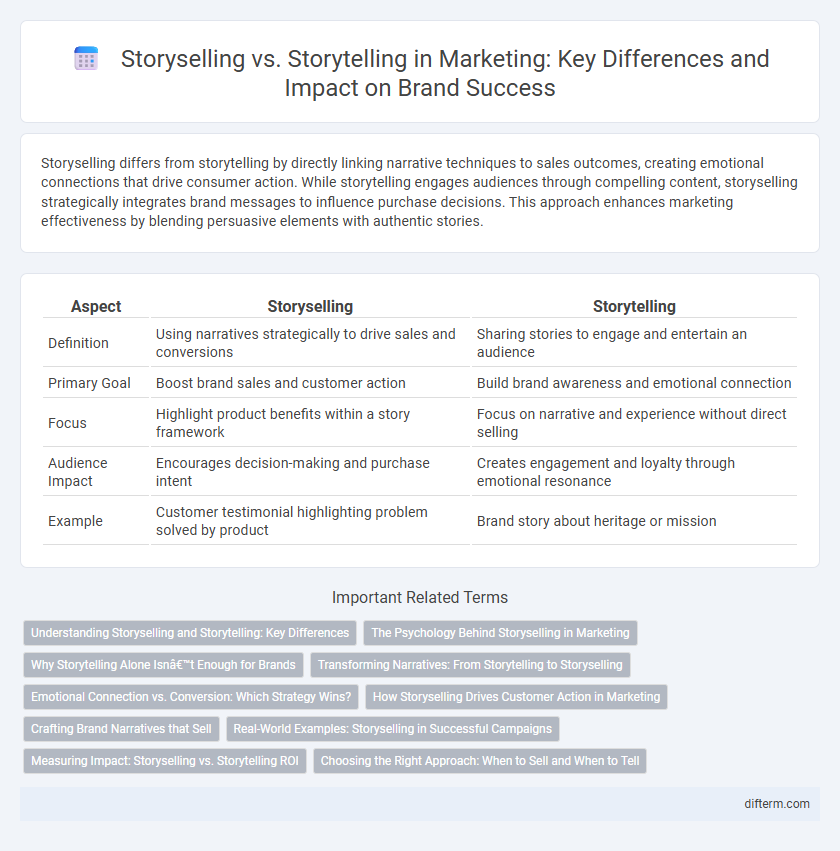Storyselling differs from storytelling by directly linking narrative techniques to sales outcomes, creating emotional connections that drive consumer action. While storytelling engages audiences through compelling content, storyselling strategically integrates brand messages to influence purchase decisions. This approach enhances marketing effectiveness by blending persuasive elements with authentic stories.
Table of Comparison
| Aspect | Storyselling | Storytelling |
|---|---|---|
| Definition | Using narratives strategically to drive sales and conversions | Sharing stories to engage and entertain an audience |
| Primary Goal | Boost brand sales and customer action | Build brand awareness and emotional connection |
| Focus | Highlight product benefits within a story framework | Focus on narrative and experience without direct selling |
| Audience Impact | Encourages decision-making and purchase intent | Creates engagement and loyalty through emotional resonance |
| Example | Customer testimonial highlighting problem solved by product | Brand story about heritage or mission |
Understanding Storyselling and Storytelling: Key Differences
Storyselling integrates persuasive marketing techniques with storytelling by focusing on creating emotional connections that drive consumer action, whereas storytelling primarily aims to entertain or inform through narratives. Effective storyselling emphasizes clear calls to action and aligns brand values with customer motivations, enhancing conversion rates and customer loyalty. Understanding these distinctions helps marketers craft campaigns that not only engage audiences but also strategically influence purchasing decisions.
The Psychology Behind Storyselling in Marketing
Storyselling leverages psychological principles such as emotional engagement, social proof, and cognitive bias to influence consumer behavior more effectively than traditional storytelling. By integrating compelling narratives with strategic calls to action, storyselling taps into consumers' desires and pain points, fostering deeper brand connections and driving conversions. Marketers harness the power of mirror neurons and the scarcity effect in storyselling to create immersive experiences that motivate purchasing decisions.
Why Storytelling Alone Isn’t Enough for Brands
Storyselling integrates emotional connection with strategic brand messaging to drive consumer action, surpassing storytelling's role of mere engagement. Brands relying solely on storytelling risk creating narratives that resonate emotionally but lack conversion mechanisms, limiting sales impact. Effective marketing campaigns must combine compelling stories with clear value propositions and calls to action to maximize brand loyalty and revenue growth.
Transforming Narratives: From Storytelling to Storyselling
Storyselling elevates traditional storytelling by integrating emotional appeal with strategic persuasion, transforming brand narratives into compelling sales tools. Emphasizing customer-centric experiences and outcome-driven messages, storyselling connects deeper with audiences to drive engagement and conversion rates. Effective storyselling harnesses data analytics and psychological triggers to craft personalized journeys that turn passive listeners into active buyers.
Emotional Connection vs. Conversion: Which Strategy Wins?
Storyselling leverages emotional connection to drive consumer behavior by integrating persuasive narratives that highlight product benefits, creating a direct pathway to conversion. Storytelling builds brand identity through relatable, emotionally resonant content that fosters long-term loyalty but may not immediately boost sales. Marketers must balance storytelling's brand equity with storyselling's conversion-focused approach to maximize ROI and customer engagement.
How Storyselling Drives Customer Action in Marketing
Storyselling transforms traditional storytelling by integrating persuasive messaging that directly connects with customer emotions and needs, triggering immediate action. By weaving product benefits into compelling narratives, marketers create memorable experiences that enhance brand loyalty and drive conversions. This strategic approach leverages psychological triggers and clear calls-to-action, making customer engagement more impactful and measurable.
Crafting Brand Narratives that Sell
Storyselling transforms storytelling by integrating emotional connection with strategic calls-to-action, driving consumer engagement and boosting conversion rates. Crafting brand narratives that sell requires aligning authentic stories with consumer desires, ensuring the message resonates deeply while propelling purchasing decisions. Effective storyselling leverages customer pain points and aspirations, creating memorable experiences that foster loyalty and enhance brand equity.
Real-World Examples: Storyselling in Successful Campaigns
Storyselling transforms traditional storytelling by embedding persuasive brand messages within emotionally engaging narratives, demonstrated by Nike's "Just Do It" campaign, which links personal achievement to product use. Coca-Cola's "Share a Coke" campaign personalizes consumer interaction by incorporating individual names, effectively driving emotional connection and boosting sales. Airbnb's user-generated storyselling leverages authentic customer experiences, building trust and community that significantly enhances booking rates.
Measuring Impact: Storyselling vs. Storytelling ROI
Storyselling drives higher ROI by directly linking brand narratives to consumer behavior and sales metrics, enabling marketers to quantify impact through conversion rates and customer engagement analytics. Unlike traditional storytelling, storyselling integrates persuasive elements that prompt immediate action, making performance tracking via KPIs like lead generation and revenue growth more effective. Measuring impact in storyselling involves analyzing data-driven results to optimize marketing strategies, contrasting with storytelling's qualitative benefits that are harder to quantify.
Choosing the Right Approach: When to Sell and When to Tell
Storyselling integrates persuasive sales techniques within narrative frameworks to directly influence consumer purchase decisions, ideal during product launches or promotional campaigns. Storytelling emphasizes building brand identity and emotional connections through compelling narratives, effective for long-term audience engagement and brand loyalty. Selecting between storyselling and storytelling depends on marketing objectives: prioritize storyselling for conversion-driven goals and storytelling for cultivating sustained customer relationships.
Storyselling vs storytelling Infographic

 difterm.com
difterm.com